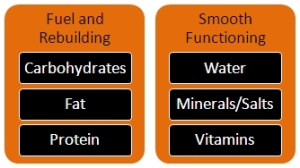
Originally published here on 18-Jan-2014 at www.Enerzal.me
So What if You Couldn’t Solve it Earlier – You can Now!
I am often invited to speak in public about “A Philosophy of Fitness: A practical guide to get fitter and stay motivated”. During that talk I always ask “How many types of nutrients are there in food?”. Although most school children below the age of 10 can answer this, almost no adult can. Shockingly, most children above the age of 10 have also forgotten. The fact that this is taught at an early age indicates its importance to our lifelong health. After all, we don’t teach this to our children because it is useless! Why we forget such things is a topic I will discuss in a future blog. Today, let me talk to you about viewing food through that functional lens – its nutrients.
Let us first understand these nutrient groups, how best to remember them and, most importantly, ways to develop a healthy relationship with them.
Fuel First

In human history, our evolution to urban or rural living is very recent. We have evolved, but are still predominantly like earliest man – hunting and gathering food primarily for energy to be able to hunt again. So, let us think of food as being first about fuel. Of the 6 nutrient types from food, the first 3 can provide us this fuel – carbohydrates, fat and protein. Protein tends to be more difficult to source (a deer is difficult to catch) and also the most expensive to buy – a steak (protein) is more expensive than fries (carbohydrates deep fried in fat!). In general, therefore, it’s best to think of proteins as being used for the primary function of tissue building rather than for fuel. These 3 energy providing nutrients are also easier to “see” physically. So when you see a hamburger – it’s literally carbohydrates on either side of a lump of protein grilled in fat.

Small is Superb
The next 2 nutrient groups are less obvious to see and are thought of as being micronutrients. Minerals (and various salts) and vitamins (have you ever actually seen a vitamin walking around or hanging on a tree and been able to identify it as such?). The various minerals and vitamins are needed in tiny quantities (almost always less than 10g) but they are nevertheless important – required to enable the various chemical reactions in your body. In fact, vita in the word vitamin means life in Latin. The 6th nutrient group is water – without which there would be no life, not even on Mars!
Committing to Memory

Given that as adults we forget this simple list of 6, what is a simple way to remember it forever? Picture your breakfast being a plate of eggs with toast, and a glass of orange juice. Easy to picture, right? All the 6 nutrient types are represented in that breakfast – the macronutrients (protein in the eggs, carbohydrates in the bread, fat in the butter), the micronutrients (vitamins in the orange, salt on your eggs) and water (in the juice). Easy to remember now? Promise yourself that you will use this visual image and never forget again? Good, so what’s next?
Add, Subtract, Substitute – it isn’t Algebra

From this point there are 3 paths you can look down – Removal, Addition and Replacement. If you remove the juice – “bye bye vitamins with water”. If you remove the eggs – “farewell dear protein” – and so on. Remembering that there are many types of each nutrient (e.g. Oranges are high in Vitamin-C but do not contain Vitamin-D naturally) you could add other foods to “balance the meal”. If I want to remove some unhealthy fat from this breakfast, I could have the toast without butter (remembering that the fat in the egg yolk actually carries a higher percentage of most of the nutrients of an egg than the white does!). If I wanted my carbohydrates to be of even higher quality, I would replace the toast with a banana (my current favourite breakfast switch).
Play with the Puzzle
To engage with your food you can think of each of your meals as being a little jigsaw puzzle with 6 pieces to put together a complete and balanced picture. Each piece has flexibility and you have the power to create each of the pieces to put together that meal’s jigsaw puzzle.
Remember also that each of the nutrient types is of no less or more importance than the others. Too much of any one type can cause problems, as can being deficient in another. Even the master of evil, fat, is extremely important for the healthy functioning of our body.
There Exists More Detail
We haven’t touched upon the quantities of each nutrient type that we should ensure we consume in a typical day on a regular basis. We have not delved into the details of what the healthiest sources of each might be. And we have not talked about when one might want to consume a little bit more or a little bit less of any one of them. Today was mostly about you simply remembering what the main nutrient groups are.
Baby Steps
We know that being mindful of anything creates a tendency for us to perform better at it. If you approach each and every meal with the idea of this jigsaw puzzle, you will begin to create a mindset where you think more actively about the nutritional properties of the food you eat. I have emphasized the importance of increasing mindfulness through repeated effort. Perhaps at your first attempt all you do is identify some of the nutrient groups. In time, you will be able to identify different types of nutrients within each food item and speak a lot more about their benefits. One step at a time – the power of miniscule change!
Wimbledon Champion as Smart as a Day Labourer
The specific nutritional qualities that are present in any food, even the humble banana that both the poor day labourer in India and the millionaire Wimbledon champion enjoy, can be easily checked even on your smartphone. Perhaps the day labourer eats his banana without much thought. But does he complete the jigsaw puzzle at every meal? More importantly, do you want to think like a Wimbledon champion? You can – just start at your next meal!!
Puru
Dr Purnendu Nath spends his waking hours focusing on helping individuals and organizations reach their goals, to make the world a better place. He speaks, writes and advises on topics such as finance, investment management, discipline, education, self-improvement, exercise, nutrition, health and fitness, leadership and parenting.


[…] With full knowledge that you have a large range of tasty and healthy foods to choose from, you will avoid the harmful path of food that is bad for you with only positive feelings. You have now, with beautiful ease, constructed choices from a set of only healthy foods that are wide in their range of appeal from a taste, texture, smell or colour perspective. After deciding that something is good for you, you need to ask, how much? Quite simply, eat all the food that is healthy. What you like a lot, eat more of, what you don’t like, eat less of. Of course, bear in mind that you need to have a meal balanced in terms of nutrients. […]
LikeLike
[…] to food. In previous blogs I have discussed how you might consider engaging with food in terms of what to eat, how much to eat, how to say no to situations you feel create disharmony between you and food, as […]
LikeLike
[…] Timing is Everything… on The Jigsaw Puzzle […]
LikeLike
[…] my earliest blogs I spoke to you about food nutrition groups and then about the fuel you get from some them. Numerous questions from both athletic and sedentary […]
LikeLike
[…] age, religion, region, wealth… the list is long. In my earliest blogs I spoke to you about food nutrition groups. Today I am going to talk about inclusion and exclusion in food – something you can actually […]
LikeLike
[…] are bad don’t get better the more you get of them. Remembering the idea of the jigsaw puzzle in a previous blog, it should be clear that sizes of dessert servings should be kept small in order to get the right […]
LikeLike
[…] Information once stored comes in handy later for solving problems (e.g. getting to your favourite restaurant) and at times it can be debilitating (e.g. fear of approaching your boss to ask for a pay rise because of experiences in your childhood or recent past). Handling that internal information consciously is also important for thriving. Being conscious of your power to try to retrieve only useful information will make you feel more in control of your own life. Your internal information is your knowledge – and knowledge is power! Focus on quality not just quantity. But, with regards to quantity, remember that knowledge builds on knowledge – you can’t read unless you know the alphabet! You won’t eat healthily if you don’t even know something as simple as what the nutrient groups are! […]
LikeLike
[…] Because pure fat consumption will not stimulate insulin production, when you are in the fasting window, you could consume fat [unless fasting for routine blood tests]. This could take the form of coconut oil in your black coffee (bulletproof coffee), or even oil with medium chain triglycerides. However, unless you are a super-lean ultra-endurance athlete, just stick to having the healthy fats only during your feeding window. Keep your fasting window free of macronutrients (carbs, proteins, fats). [Read this for a previous conversation about macro/micro-nutrients.] […]
LikeLike
[…] on the type of training session you are about to do, and your approach to fuels in the macronutrients relative to your training cycle (e.g. carb loaded run, glycogen depleted run) you will have to spec […]
LikeLike